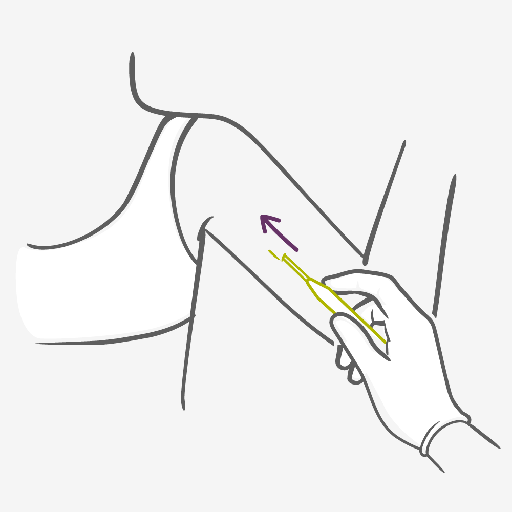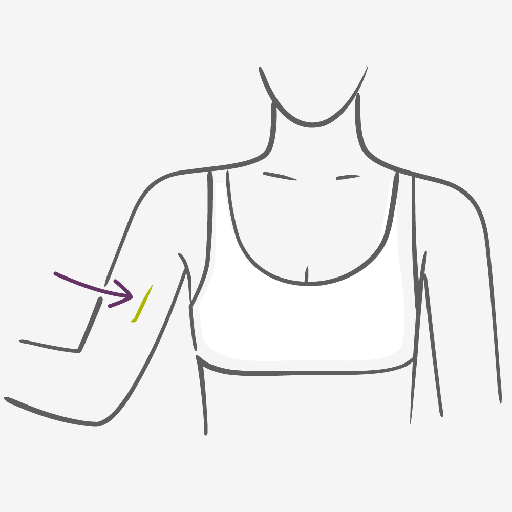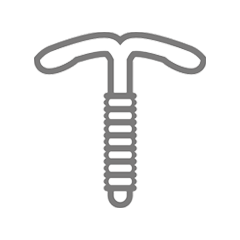CONTRACEPTIVE IMPLANT
WHEN and HOW?
The contraceptive implant is highly effective - the efficacy is 99% with typical use. The implant should be inserted within 7 days after the onset of menstrual bleeding, or immediately or within 7 days after abortion. If the contraceptive implant is inserted at any other time, you will need to use an additional non-hormonal (barrier) method for the following 7 days.
Before the implant can be inserted, your healthcare provider has to make sure that you are not pregnant.
How is the implant inserted?
- After local anesthesia, a well-trained healthcare provider will numb a small area of your inner upper arm and insert the implant just underneath the surface with a special needle.
- Once the placement is finalized, there is little or nothing left to do or remember. Seriously, the implant releases small amounts of hormones into your blood over the course of up to 3 or 5 years, depending on the type.
- It can be removed at any time with minor surgery by your healthcare provider. Once the implant is removed, the contraceptive effect wears off quickly and you can become pregnant as rapidly as women who have used no contraceptive at all.
It is suitable for women who want highly effective long-acting reversible contraception and wish to avoid a daily, weekly or monthly regimen.
Tabs header
Contraceptive Implant PROS:
- At 99.95%, it’s the most effective contraceptive method available
- Suitable for women who want long-acting reversible contraception for up to 3 or 5 years and wish to avoid daily, weekly or monthly regimen
- It doesn’t interrupt sex
- It can offer an alternative to those affected by the hormone estrogen
- It can be used when breastfeeding six weeks after childbirth
- It may reduce heavy and painful periods for some women
- Easy to hide
Contraceptive Implant CONS:
- It requires a trained healthcare provider for insertion and removal
- It may initially cause a change in bleeding patterns
- It may cause weight gain, breast and abdominal pain
- Does not protect against HIV infection (AIDS) and other sexually transmitted infections (STIs)
All important details about the Contraceptive Implant
The contraceptive implant might sound a little space age initially but really it’s a highly effective, easy to hide contraceptive.
About same size than a matchstick, the implant is placed just below the skin of your upper arm where it constantly releases the hormone progestin in small doses from a reservoir into your blood stream. The hormone keeps your ovaries from releasing eggs but also thickens your cervical mucus making it hard for sperm to move around in the womb and fertilize an egg.
The contraceptive implant can be used when breastfeeding six weeks after childbirth. This method can also offer an alternative to those affected by the hormone estrogen as it releases the hormone progestin only.

Questions and Answers about the Implant
FREQUENTLY ASKED QUESTIONS
The implant contains a progestin reservoir which is released in tiny doses during the three years or five years depending on the type to prevent pregnancy. It will need to be replaced after this time as the hormone reservoir will run out.
The implant is about the size of a thin matchstick, and people have it inserted under the skin of the inner side of the upper arm. It can easily be felt, but it is not very visible, except to someone who is looking for it. There will be a tiny mark at the point of insertion, but this isn’t very visible providing the implant has been inserted by a trained healthcare provider.
Many women find that heavy, painful periods are reduced. There can sometimes be irregular bleeding initially, but this should go after the first few months.
After the counseling by your healthcare provider and making sure that you are not pregnant, the implant should be inserted within 7 days after the onset of menstrual bleeding, or immediately or within 7 days after abortion. If the contraceptive implant is inserted at any other time, you will need to use an additional non-hormonal (barrier) method for the following 7 days. In case of questions, please consult with your healthcare provider.
Local anesthesia is used so there should be very little pain, and the procedure takes only a couple of minutes. There might be a bit of bruising or soreness afterwards.



































